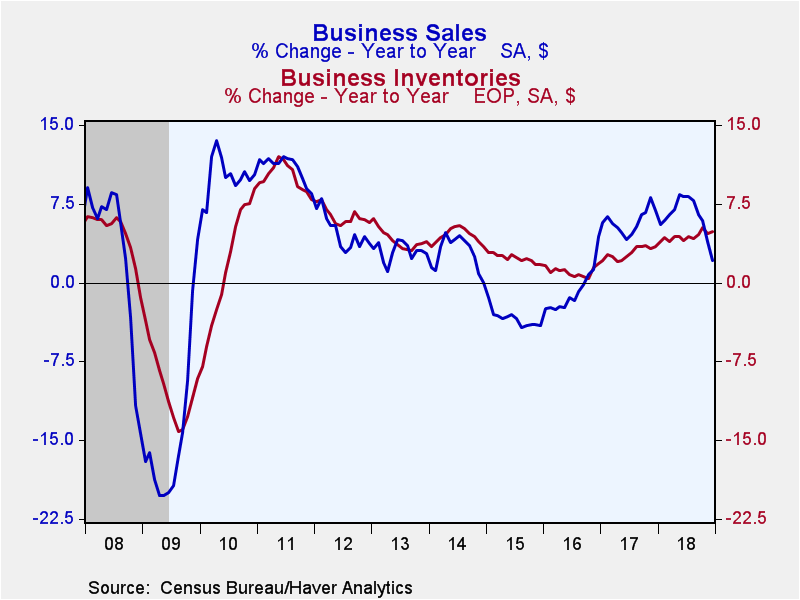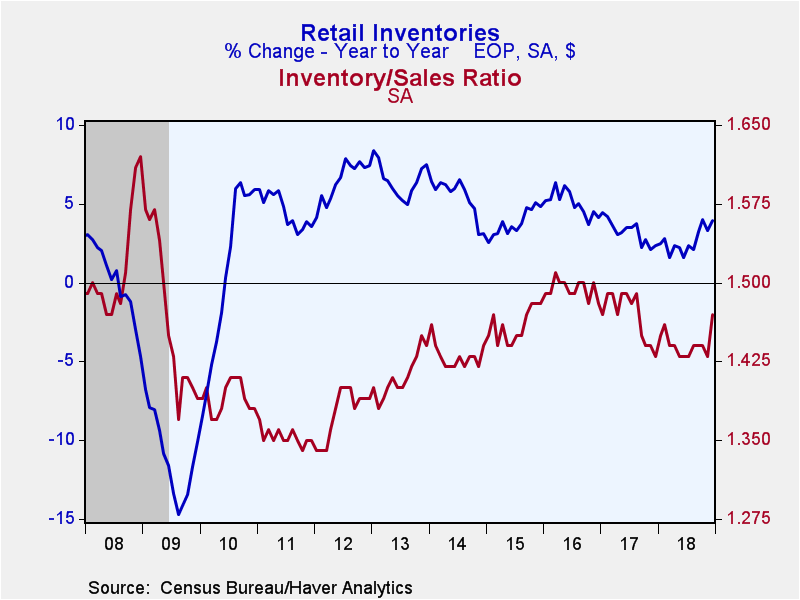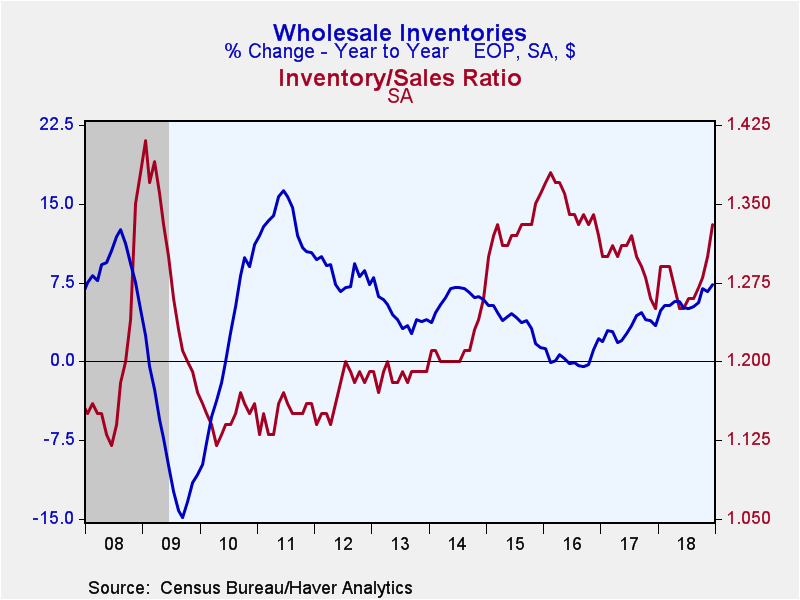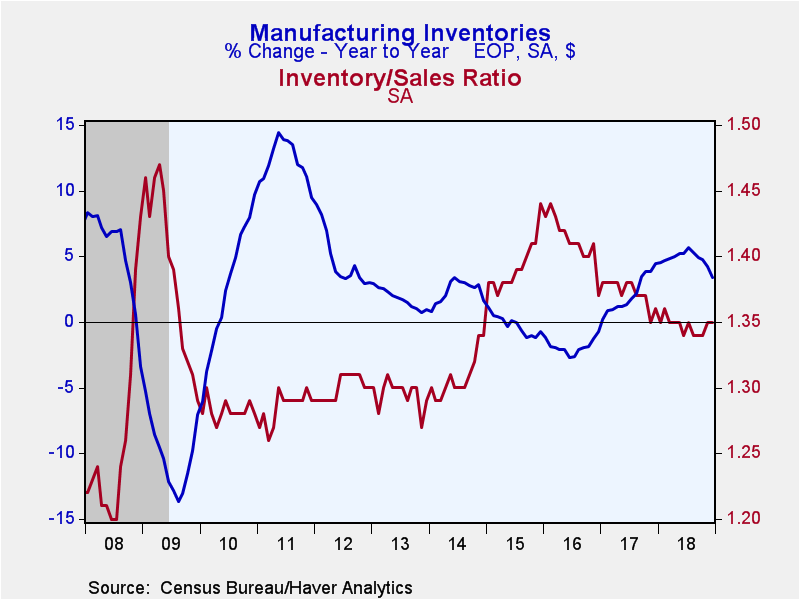 Global| Mar 11 2019
Global| Mar 11 2019U.S. Business Inventories Increase As Sales Decline
by:Tom Moeller
|in:Economy in Brief
Summary
Total business inventories rose 0.6% (4.9% y/y) during December after holding steady in November. Total business sales fell 1.0% (+1.9% y/y) following a 0.6% decline. The inventory-to-sales ratio increased to 1.38, its highest level [...]
Total business inventories rose 0.6% (4.9% y/y) during December after holding steady in November. Total business sales fell 1.0% (+1.9% y/y) following a 0.6% decline. The inventory-to-sales ratio increased to 1.38, its highest level since the middle of 2017.
Retail inventories increased 0.9% (4.0% y/y) in December following a 0.4% decline. Auto inventories improved 0.6% (9.3% y/y) for the second straight month. Non-auto retail inventories rebounded 1.0% (1.1% y/y) and recovered November's decline. General merchandise inventories rebounded 0.9% (-0.1% y/y) after a 2.1% drop. In the department store sector, inventories recovered 1.0% (-5.2% y/y) after tumbling 5.3% in the prior month. Building materials inventories rose 0.9% (7.0% y/y) after a 0.1% uptick, while clothing store inventories rebounded 1.4% (0.6% y/y) following a 0.7% decline. Inventories of furniture, electronics and appliances recovered 0.7% (-1.3% y/y) after dropping 4.6%. As reported earlier, wholesale inventories surged 1.1% (6.9% y/y) following a 0.4% increase. Factory sector inventories were fairly steady (4.2% y/y) after a 0.1% slip.
Retail sales stumbled 1.8% (+0.3% y/y) during December after holding steady. Non-auto sales moved 2.5% lower (-0.2% y/y) after little change. Wholesale sector sales fell 1.0% (+1.2% y/y), about the same as they did in November. Shipments from the factory sector eased 0.2% (+4.3% y/y), down for the third straight month.
The overall business inventory-to-sales (I/S) ratio surged to 1.38. The retail sector ratio jumped to 1.47, its highest point since August of 2017. The non-auto I/S ratio strengthened to 1.21, its highest level since April 2018. The wholesale sector I/S ratio rose to 1.33, the highest level since the middle of 2016. The manufacturing sector I/S ratio held steady at 1.35 and remained near the three-year low.
The manufacturing and trade data are in Haver's USECON database.
| Manufacturing & Trade | Dec | Nov | Oct | Dec Y/Y | 2018 | 2017 | 2016 |
|---|---|---|---|---|---|---|---|
| Business Inventories (% chg) | 0.6 | -0.0 | 0.6 | 4.9 | 4.9 | 3.5 | 1.9 |
| Retail | 0.9 | -0.4 | 0.8 | 4.0 | 4.0 | 2.4 | 4.1 |
| Retail excl. Motor Vehicles | 1.0 | -0.9 | 0.6 | 1.1 | 1.1 | 2.4 | 2.1 |
| Merchant Wholesalers | 1.1 | 0.4 | 0.9 | 6.9 | 7.3 | 3.6 | 2.2 |
| Manufacturing | -0.0 | -0.1 | 0.2 | 4.2 | 3.5 | 4.5 | -0.7 |
| Business Sales (% chg) | |||||||
| Total | -1.0 | -0.6 | 0.1 | 1.9 | 6.5 | 5.4 | -0.6 |
| Retail | -1.8 | 0.0 | 1.1 | 0.3 | 4.8 | 4.5 | 2.8 |
| Retail excl. Motor Vehicles | -2.5 | -0.0 | 0.9 | -0.2 | 5.3 | 4.5 | 2.2 |
| Merchant Wholesalers | -1.0 | -1.2 | -0.6 | 1.2 | 7.5 | 7.0 | -1.3 |
| Manufacturing | -0.2 | -0.5 | -0.1 | 4.3 | 7.0 | 4.7 | -3.0 |
| I/S Ratio | |||||||
| Total | 1.38 | 1.36 | 1.35 | 1.34 | 1.35 | 1.38 | 1.42 |
| Retail | 1.47 | 1.43 | 1.44 | 1.43 | 1.45 | 1.48 | 1.49 |
| Retail excl. Motor Vehicles | 1.21 | 1.17 | 1.18 | 1.21 | 1.20 | 1.24 | 1.28 |
| Merchant Wholesalers | 1.33 | 1.30 | 1.28 | 1.25 | 1.28 | 1.30 | 1.35 |
| Manufacturing | 1.35 | 1.35 | 1.34 | 1.35 | 1.35 | 1.38 | 1.41 |
Tom Moeller
AuthorMore in Author Profile »Prior to joining Haver Analytics in 2000, Mr. Moeller worked as the Economist at Chancellor Capital Management from 1985 to 1999. There, he developed comprehensive economic forecasts and interpreted economic data for equity and fixed income portfolio managers. Also at Chancellor, Mr. Moeller worked as an equity analyst and was responsible for researching and rating companies in the economically sensitive automobile and housing industries for investment in Chancellor’s equity portfolio. Prior to joining Chancellor, Mr. Moeller was an Economist at Citibank from 1979 to 1984. He also analyzed pricing behavior in the metals industry for the Council on Wage and Price Stability in Washington, D.C. In 1999, Mr. Moeller received the award for most accurate forecast from the Forecasters' Club of New York. From 1990 to 1992 he was President of the New York Association for Business Economists. Mr. Moeller earned an M.B.A. in Finance from Fordham University, where he graduated in 1987. He holds a Bachelor of Arts in Economics from George Washington University.










